
Price predictions 9/29: SPX, DXY, BTC, ETH, XRP, BNB, SOL, DOGE, ADA, HYPE Cointelegraph
source
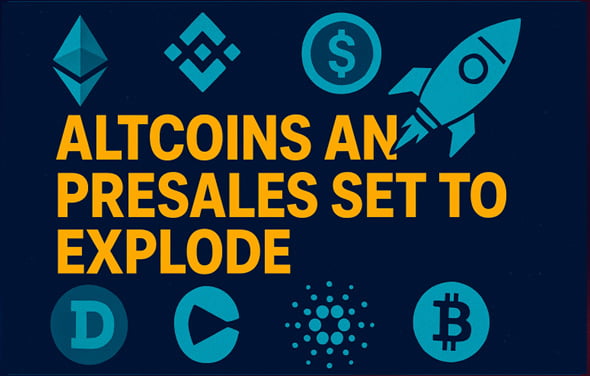
The cryptocurrency world is always buzzing with excitement, and investors are constantly on the lookout for the next crypto to explode. With so many coins and projects out there, it can be hard to know which ones are worth your money.
In this article, we’ll dive into altcoins and presales that have the potential to explode. These projects have unique features, strong communities, and the potential for big growth. One crypto that has been on investors’ radar is Dawgz AI, an Ethereum-based token that is merging AI with meme culture to offer fun and profitability.
Let’s start our list with the token that has left investors not only turning their heads but flocking to its presale to buy tokens at a discount before the $1 moonshot.
Dawgz AI ($DAGZ) is a new project that’s creating hype in the crypto space. Unlike most meme coins, Dawgz AI combines meme culture with AI technology, making it a strong contender for the next crypto to explode. Built on the Ethereum blockchain, Dawgz AI uses AI to power trading bots that help investors make smarter trades. These bots analyze market trends and execute trades automatically, aiming to maximize profits.
What makes Dawgz AI stand out is its presale success. As of now, the project has raised over $3.61 million, with the token priced at just $0.00438 during the presale phase. Early investors can buy tokens at a low price before they shoot. Once Dawgz AI hits major exchanges, market observers believe its value will skyrocket. $DAGZ also offers staking rewards, allowing holders to earn passive income.
The community behind Dawgz AI and SolidProof audit is another big plus. Dawgz AI hosts contests and campaigns that keep investors engaged, blending fun with real utility. If you’re looking for a low-cost entry into a project with both meme appeal and cutting-edge tech, Dawgz AI could be the next crypto to explode. Watch this video for more updates.
XRP is a crypto designed for fast and cost-efficient global payments. XRP facilitates transactions in 3–5 seconds with low fees, offering a scalable alternative to traditional systems like SWIFT. With a market cap of $139.8 billion and a current price of $2.38, XRP is already a heavyweight with room to grow, especially after its legal battle with the SEC.
Recent developments have boosted its outlook. There’s also talk of a potential XRP ETF, which could attract big investors and push the price higher. Ripple is expanding its partnerships, aiming to make XRP the go-to choice for global payments.
Additionally, XRP’s ability to settle transactions in seconds, compared to days for traditional banking, gives it a real-world use case. If Ripple secures more partnerships or an ETF gets approved, XRP could see a massive rally, making it a solid pick for investors looking for the next crypto to explode.
Solana (SOL) is a blockchain platform known for its lightning-fast transactions and low fees. With a market cap of $86.3 billion and a current market price of $166.2, Solana is a top player in the crypto world. It can process thousands of transactions per second, making it a favorite for dApps, NFTs, and DeFi projects.
Solana’s growth has been impressive, with exciting projects like Solaxy, a Layer-2 solution built on Solana that reduces congestion and improves performance. Its ability to attract developers and institutional investors makes it a strong candidate for the next crypto to explode.
Dogecoin originally started as a joke but has become a crypto icon, thanks to its loyal community and celebrity endorsements from people like Elon Musk. With a market cap of $33.56 billion and a current price of $0.2266, Dogecoin remains a fan favorite.
Dogecoin aims to get millions of retailers to accept DOGE as a payment option. If this plan succeeds, Dogecoin could see wider adoption, pushing its price toward $1 or higher. Still, its strong community and potential for mainstream use keep it in the conversation as a crypto to watch.
Cardano focuses on sustainability, scalability, and interoperability. At press time, the market cap of ADA sits at $26.2 billion, and trading at $0.74. Its research-driven approach, led by Ethereum co-founder Charles Hoskinson, sets it apart from other projects.
Cardano has been making big strides, including adding smart contract functionality and expanding its DeFi ecosystem. Cardano’s focus on eco-friendly technology and peer-reviewed development makes it appealing to long-term investors. If its DeFi and NFT sectors grow, Cardano could be the next crypto to explode.
Each of these altcoins and the Dawgz AI presale has something unique to offer. Dawgz AI brings AI-powered trading and meme coin fun, with massive presale momentum.
XRP is a leader in cross-border payments, with regulatory clarity and ETF potential. Solana’s speed and developer-friendly platform make it a DeFi powerhouse, despite past outages. Dogecoin’s community and new initiatives keep it relevant, while Cardano’s research-driven approach and growing ecosystem make it a safe bet for the future.
Before jumping into investing in crypto, here are a few tips to keep in mind:
The crypto market is full of opportunities, and Dawgz AI ($DAGZ) stands out as a promising altcoin in 2025, blending meme coin virality with AI-driven trading tools.
Dawgz AI automated trading bots offer retail investors access to sophisticated market analytics. For investors who want to get returns with much ease, they can buy Dawgz AI, while it is still in presale, automate their investments, and start making passive income.
Disclaimer: This media platform provides the content of this article on an “as-is” basis, without any warranties or representations of any kind, express or implied. We assume no responsibility for any inaccuracies, errors, or omissions. We do not assume any responsibility or liability for the accuracy, content, images, videos, licenses, completeness, legality, or reliability of the information presented herein. Any concerns, complaints, or copyright issues related to this article should be directed to the content provider mentioned above.
Editor-in-Chief of CoinCentral and founder of Kooc Media, A UK-Based Online Media Company. Believer in Open-Source Software, Blockchain Technology & a Free and Fair Internet for all. His writing has been quoted by Nasdaq, Dow Jones, Investopedia, The New Yorker, Forbes, Techcrunch & More. Contact Oliver@coincentral.com
We’re about to head into Q4, and if history’s any guide, this is when crypto…


For premium support please call:
For premium support please call:
Riska/Getty Images
When it comes to packing for a trip, most of us fall into one of two camps: the chronic overpackers who cram in “just in case” outfits they’ll never wear, or the frazzled under-packers who inevitably forget their phone charger, their favorite shoes … or even a change of underwear. But Shaniece Jones, professional organizer and founder of Closet Therapy, says it doesn’t have to be this way.
Jones swears by a streamlined system that makes packing—and therefore travel in general—less stressful (and dare we say?) even pleasant. “When you plan ahead and pack intentionally, you spend less time worrying about your stuff and more time actually enjoying your trip,” she says. Here are her tried-and-true tricks for getting out the door with less stress and a perfectly packed bag.
“The No. 1 mistake people make is overpacking,” Jones says. “We try to prepare for every possible ‘just in case’ moment, or we pack every toiletry we own, even the ones we never actually use at home.”
Instead of thinking about what you might need, Jones says the key is to plan around what you will do. She even challenges herself to fit everything into a carry-on and a small tote or backpack, no matter how long the trip. “The less time you spend waiting at baggage claim, the more time you have for the fun stuff.”
Jones is a big fan of a packing list—but not the kind that’s just a jumble of socks, toothpaste, and sweaters. Instead, she builds her list day by day. “I map out what I’ll be doing each day and assign an outfit for that activity. That way, I prevent overpacking while making sure I have what I actually need.”
She also keeps a running note on her phone for specific things she’s forgotten before—like her strapless bra or charger block—so those one-time “oops” moments don’t repeat themselves.
The rolling vs. folding debate has divided travelers for years, but Jones doesn’t pick sides. “There’s a time to roll and a time to fold,” she says. She rolls lightweight pieces like tees and pajamas but folds bulkier items like sweaters and sweatsuits.
Her secret weapon is packing cubes. “They’re like drawers in your suitcase,” Jones explains. “They keep everything contained, make it easier to find what you need, and prevent your clothes from shifting around.”
If wrinkles are your packing nemesis, Jones has a few tricks. First, she chooses fabrics that don’t wrinkle easily. For dressier pieces like a crisp white button-down, she folds along natural seams and sometimes tucks a sheet of acid-free tissue paper inside.
Shoes are notoriously bulky, but Jones recommends editing mercilessly. “Two to three pairs are plenty,” she says. One pair can do double duty for the plane and the gym. Another can rotate through most daytime looks, and the third can be your going-out shoe. “The key is versatility—pick shoes that mix and match across outfits.”
There’s nothing worse than opening your suitcase to find shampoo leaked all over your clothes. To prevent disasters, Jones decants liquids into travel-size jars and bottles, stores them in a clear zip bag, and keeps them separate from clothes.
She also recommends simple household helpers to assist your compartmentalization process. “Ziploc bags are great for swimsuits or accessories—they’re inexpensive, reusable, and keep your suitcase organized.”
According to Jones, stress-free packing starts with timing. For longer trips, she starts about a week out. “That way, you have time to shop for or replace anything you’re missing.” For weekend getaways, three days is plenty.
She also swears by doing laundry first. “Nothing slows you down like realizing your favorite jeans are still in the hamper.”
To make packing less overwhelming, Jones keeps a pre-packed “go bag” with duplicates of her everyday toiletries and other essentials. “I check it monthly so I’m never scrambling,” she says. “It’s one less thing to think about when you’re trying to get out the door.”
Jones cautions travelers to be mindful about souvenirs. “They can quickly eat up suitcase space. Before buying, I ask myself: Is this useful, is there a smaller version, and will the person I’m buying for actually use it?” She also leaves a little space in her suitcase before she leaves home, so she has room to bring back something truly meaningful without stress.
If you only adopt one of her tips, make it this one: Stop packing for the just-in-case. Jones says those items are almost always the ones that never see daylight on your trip. “Pack for the life you’re actually going to live on vacation—not the one you might want to live.”
With Jones’ thoughtful, streamlined approach, packing shifts from a dreaded chore to a doable part of travel prep. A little planning, some versatile pieces, and a set of trusty packing cubes can transform your next getaway.
“The goal is to enjoy the trip, not stress about your suitcase,” she says. “When you’re not weighed down, literally or figuratively, you get to make the most of every moment.”
Read the original article on Southern Living
Advertisement
Advertisement
Advertisement
Advertisement
Advertisement
Advertisement
Advertisement
Advertisement
Advertisement
Advertisement

Coins
Top 100 Coins
Trending Cryptos
Performance
Recently Listed
Gainers
All Categories
All Time High
Blockchains
Global Market Data
Ecosystems
Fundraising
Funding Rounds
Funds
Analytics Dashboard
IDO/ICO
IDO/ICO
IDO Launchpad ROI
Launchpads
CEX Launchpad ROI
Launchpool
Analytics Dashboard
Node Sale
Exchanges
CEX
CEX Transparency
CEX Listing Performance
DEX
Exchange Tokens
ETH Bridge
Token Unlocks
Token Unlocks
Analytics
VC Pressure
Products
Research
Rewards
Maps
Drop Hunting
Alerts
Converter
Widgets
Market Data API
Futures and Options
Affiliate Program
Watchlist
Portfolio
One mysterious whale has been quietly accumulating PI tokens even as the broader market rushes to dump them – raising the question: what does this buyer know that others don’t, and does it point to a bullish Pi Coin price prediction?
Despite launching with major hype, Pi (PI) has struggled to live up to expectations, crashing by 91% from its all-time high of $2.98 set back in February.
This wallet’s aggressive accumulation suggests it may be operating on privileged information or strong insider conviction.
According to Pi Scan, wallet GASWBD[…]ODM currently holds 383.3 million PI, worth around $103 million – making it the 7th largest Pi holder overall, ahead of major exchanges like Gate.io and Bitget.
Even more intriguing, this whale added 6.3 million PI tokens to their stack in the past week alone, signaling continued confidence despite the wider market’s retreat.
The identity of GASWBD[…]ODM remains a mystery, but its positioning has sparked widespread speculation.
Could this investor have early access to Pi’s roadmap, insider knowledge of an exchange listing, or an upcoming ecosystem update?
Whatever the case, it adds serious weight to the bullish Pi Coin price prediction thesis – especially if other large players start following suit.
Pi has rebounded slightly after hitting a new all-time low near $0.22, consolidating around $0.26 in recent sessions.
However, continued market weakness could drag the token back toward last week’s lows.
On the 4-hour chart, the Relative Strength Index (RSI) is beginning to show signs of recovery, hinting that Pi Coin might attempt a retest of the $0.30 mark.
Still, unless the token break out from its current downtrend decisively, the overall setup continues to support a bearish outlook.
If bearish momentum accelerates, the $0.20 level becomes a likely target – implying a 26% downside risk from current levels.
Rather than holding underperforming tokens this cycle, many traders are turning their focus to high-upside presales showing strong momentum.
One standout is Pepenode ($PEPENODE), a new project that enables users to build virtual mining rigs and earn crypto.
Pepenode ($PEPENODE) lets users build their own virtual meme coin mining rig.
You can buy nodes, build server rooms, and earn more crypto by building more rigs.
The game leverages the popularity of the Pepe meme and combines it with an innovative virtual mining model that consists of buying and upgrading rigs to climb the leaderboard.
Buyers will use $PEPENODE to set up and boost their mining operation while competing for attractive rewards, like airdrops of top meme coins like Pepe ($PEPE) and Bonk ($BONK).
Every upgrade performed to a node adds a deflationary twist: 70% of the tokens spent on improving rigs are burned permanently, reducing the circulating supply as the community expands.
As the game gains popularity, the demand for $PEPENODE could skyrocket.
To buy $PEPENODE at its presale price, visit the official Pepenode website and connect your wallet (e.g. Best Wallet).
You can either swap crypto or use a bank card to get started.Visit the Official Website Here
The post Pi Coin Price Prediction: Price Crashes 91% From ATH – But Why Is a Mystery Whale Still Buying? appeared first on Cryptonews.
Read More
One mysterious whale has been quietly accumulating PI tokens even as the broader market rushes to dump them – raising the question: what does this buyer know that others don’t, and does it point to a bullish Pi Coin price prediction?
Despite launching with major hype, Pi (PI) has struggled to live up to expectations, crashing by 91% from its all-time high of $2.98 set back in February.
This wallet’s aggressive accumulation suggests it may be operating on privileged information or strong insider conviction.
According to Pi Scan, wallet GASWBD[…]ODM currently holds 383.3 million PI, worth around $103 million – making it the 7th largest Pi holder overall, ahead of major exchanges like Gate.io and Bitget.
Even more intriguing, this whale added 6.3 million PI tokens to their stack in the past week alone, signaling continued confidence despite the wider market’s retreat.
The identity of GASWBD[…]ODM remains a mystery, but its positioning has sparked widespread speculation.
Could this investor have early access to Pi’s roadmap, insider knowledge of an exchange listing, or an upcoming ecosystem update?
Whatever the case, it adds serious weight to the bullish Pi Coin price prediction thesis – especially if other large players start following suit.
Pi has rebounded slightly after hitting a new all-time low near $0.22, consolidating around $0.26 in recent sessions.
However, continued market weakness could drag the token back toward last week’s lows.
On the 4-hour chart, the Relative Strength Index (RSI) is beginning to show signs of recovery, hinting that Pi Coin might attempt a retest of the $0.30 mark.
Still, unless the token break out from its current downtrend decisively, the overall setup continues to support a bearish outlook.
If bearish momentum accelerates, the $0.20 level becomes a likely target – implying a 26% downside risk from current levels.
Rather than holding underperforming tokens this cycle, many traders are turning their focus to high-upside presales showing strong momentum.
One standout is Pepenode ($PEPENODE), a new project that enables users to build virtual mining rigs and earn crypto.
Pepenode ($PEPENODE) lets users build their own virtual meme coin mining rig.
You can buy nodes, build server rooms, and earn more crypto by building more rigs.
The game leverages the popularity of the Pepe meme and combines it with an innovative virtual mining model that consists of buying and upgrading rigs to climb the leaderboard.
Buyers will use $PEPENODE to set up and boost their mining operation while competing for attractive rewards, like airdrops of top meme coins like Pepe ($PEPE) and Bonk ($BONK).
Every upgrade performed to a node adds a deflationary twist: 70% of the tokens spent on improving rigs are burned permanently, reducing the circulating supply as the community expands.
As the game gains popularity, the demand for $PEPENODE could skyrocket.
To buy $PEPENODE at its presale price, visit the official Pepenode website and connect your wallet (e.g. Best Wallet).
You can either swap crypto or use a bank card to get started.Visit the Official Website Here
The post Pi Coin Price Prediction: Price Crashes 91% From ATH – But Why Is a Mystery Whale Still Buying? appeared first on Cryptonews.
Read More

A divergence between the XRP Fear & Greed Index and the XRP price today is fueling debate about whether the token may be approaching a cycle top.
Data highlighted in an X post shows that sentiment has fallen into “fear” territory even as the price of XRP continues to rise. This same pattern emerged in 2020–2021 before the last major market peak, raising questions about whether history could be repeating.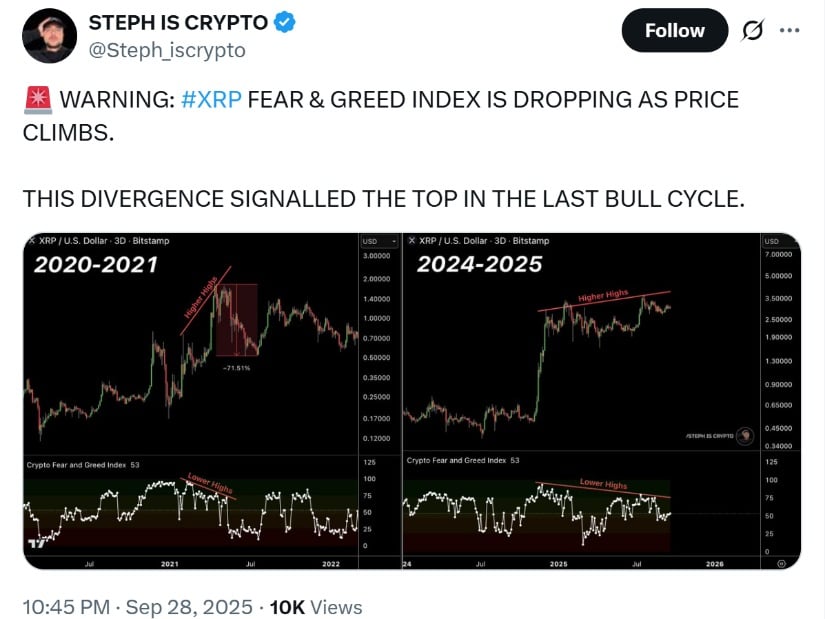
The XRP Fear & Greed Index is falling while the price climbs, echoing a divergence that signaled the previous bull cycle top. Source: @Steph_iscrypto via X
According to CFGI data, XRP entered “Daily Extreme Fear” on February 6, 2025, followed by “Daily Fear” on September 1, 2025. While these readings may look troubling, experts caution that fear and greed indexes are built on market psychology rather than fundamentals, limiting their predictive power.
The XRP SEC lawsuit, first filed in December 2020, added significant volatility to Ripple’s token during the last bull cycle. That case was resolved in 2025 with a $125 million settlement, removing a major cloud over Ripple and helping clarify XRP’s regulatory status. Analysts note that while the lawsuit contributed to the 2020–2021 market top, the same risk may not apply now, given the legal closure.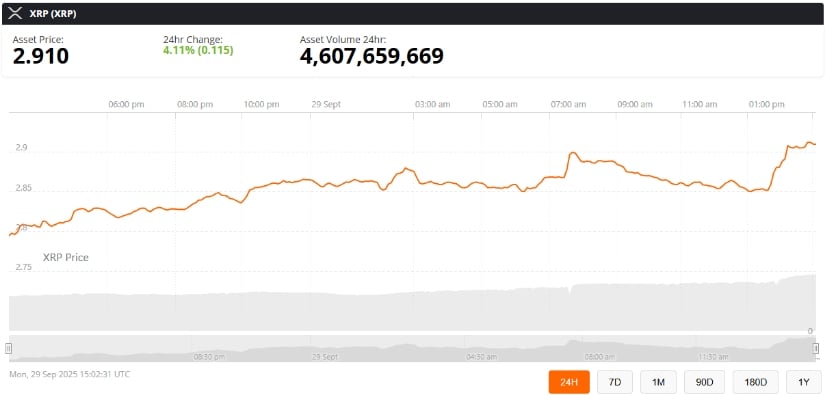
XRP was trading at around $2.91, up 4.11% in the last 24 hours at press time. Source: XRP price via Brave New Coin
Still, regulatory dynamics remain a core driver of sentiment. Uncertainty has historically been one of the biggest catalysts for volatility in cryptocurrency XRP. With the Ripple case now resolved, the regulatory landscape has become clearer, reducing some of the risks seen in previous cycles. However, market psychology may continue to influence trading behavior, even in this more stable environment.
Adding to the mix, optimism over a potential XRP ETF approval is rising sharply. Data from Polymarket shows traders pricing in a 99% chance of approval by December 31, 2025. This surge in confidence follows the SEC’s withdrawal of its appeal against Ripple earlier in March, which further reduced regulatory ambiguity.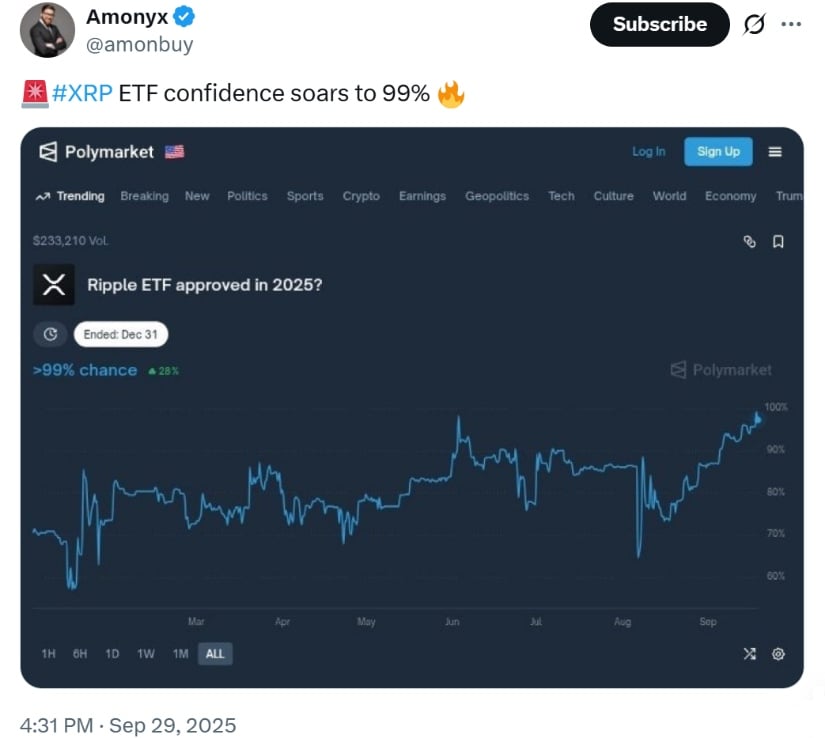
Market confidence in XRP ETF approval has surged to 99%. Source: @amonbuy via X
Cointelegraph estimates that approval could attract between $4–$8 billion in inflows, potentially transforming the Ripple XRP price trajectory. However, some analysts warn that investors should remain cautious of a “sell the news” reaction, as much of this optimism may already be reflected in the current XRP price of around $2.91.
From a technical perspective, XRP price predictions remain mixed. The token has been consolidating within a descending triangle since July, with resistance capped near $2.96 and support sitting close to $2.70. Analysts highlight that a close above $3.00 could trigger a breakout toward $3.25–$3.42, while a drop below $2.75 could open the door to deeper losses near $2.50.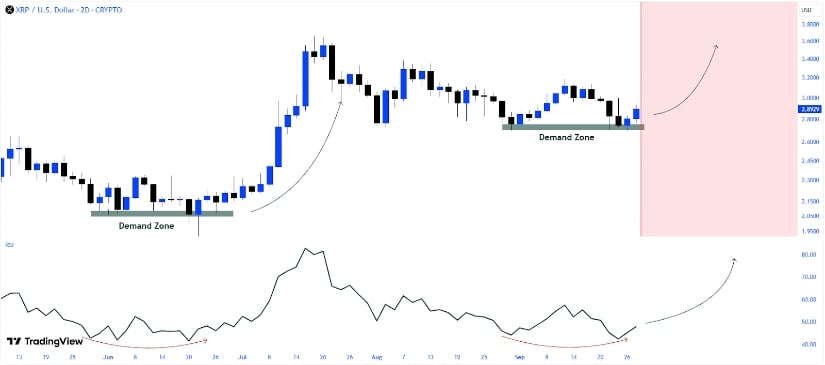
A TradingView post suggests XRP/USD is regaining momentum as the price rebounds from a key demand zone. Source: EtherNasyonaL on TradingView
Market sentiment around Ripple XRP news today remains divided. Analyst Hardy noted, “XRP is still in a solid bullish consolidation. As long as the price holds above $2.72–$2.75, the upside potential remains in play.” Another analyst, XForceGlobal, added that prolonged consolidation could build pressure for a stronger breakout, with longer-term targets as high as $20–$30 being discussed in bullish circles.
Historically, October has not been a strong month for XRP. Since 2013, the token has recorded negative returns in seven of the past 12 Octobers. However, Q4 has consistently been XRP’s best-performing quarter, averaging 51% gains. In 2024, XRP surged 240% in Q4 alone, highlighting the potential for sharp reversals in the final months of the year.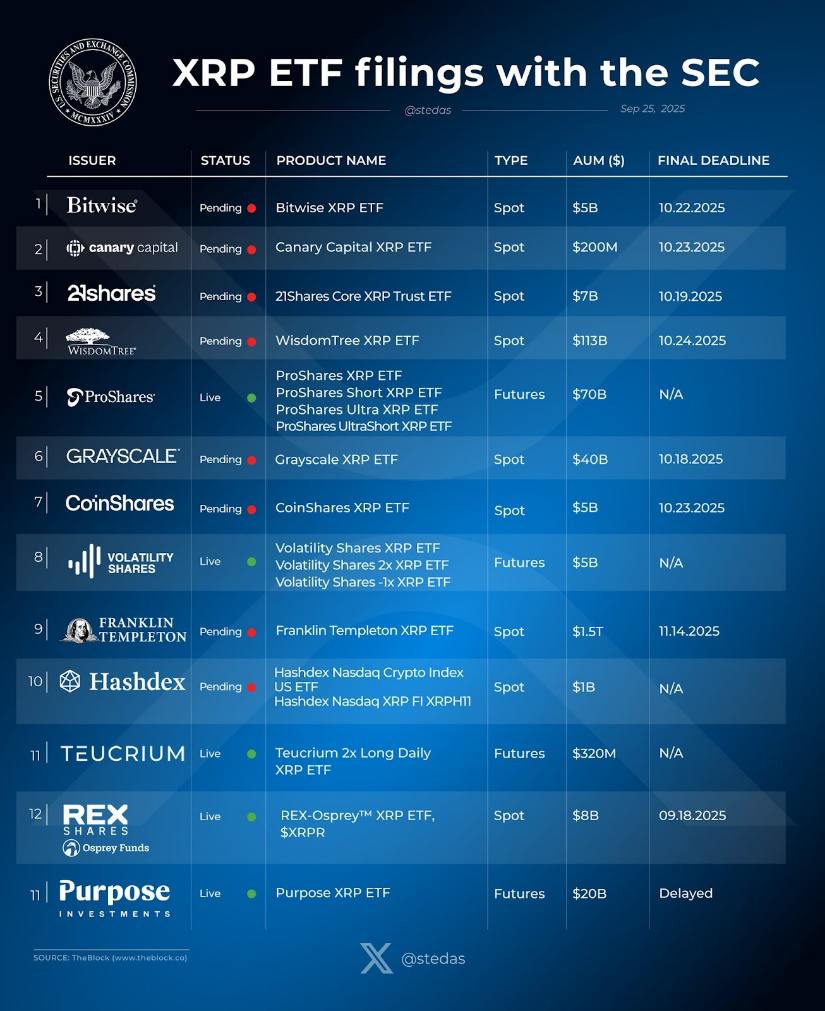
October is set to be historic for XRP as multiple spot ETF decisions from major issuers are scheduled between October 18 and 25. Source: @TheCryptoSquire via X
This seasonal pattern, coupled with ETF optimism and institutional demand, could set the stage for what some traders are calling “Uptober.” Whether or not XRP mirrors past cycles, the coming weeks may prove decisive in shaping the XRP forecast 2025.
30 Sep 2025
30 Sep 2025
30 Sep 2025
Naveed Iqbal|30 Sep 2025|News|
Naveed Iqbal|30 Sep 2025|News|
Naveed Iqbal|30 Sep 2025|News|
Ahmed Ishtiaque|30 Sep 2025|News|
Naveed Iqbal|30 Sep 2025|News|
Auckland / Melbourne / London / New York / Tokyo
A Techemy company
PO Box 90497, Victoria St West, Auckland Central, 1010, New Zealand.
© 2025 Brave New Coin. All Rights Reserved.
Sponsored

On September 14, 2025, a pro-Islamic State (ISIS) outlet which publishes ISIS material in Turkish published a poster containing a QR code and a message in Arabic, Turkish, English and Russian, listing a Monero wallet for donations. It provided a Telegram bot for inquiries about donating other cryptocurrencies.
The full text of this report is available to MEMRI Jihad and Terrorism Threat Monitor subscribers.
Subscription information is available at this link.
JTTM subscribers can visit this page to view the report.
MEMRI is a 501(c)3 organization. All donations are tax-deductible and kept strictly confidential.
MEMRI is a 501(c)3 organization. All donations are tax-deductible and kept strictly confidential.
© 1998-2025, The Middle East Media Research Institute All Rights Reserved. Materials may only be cited with proper attribution
Privacy Policy
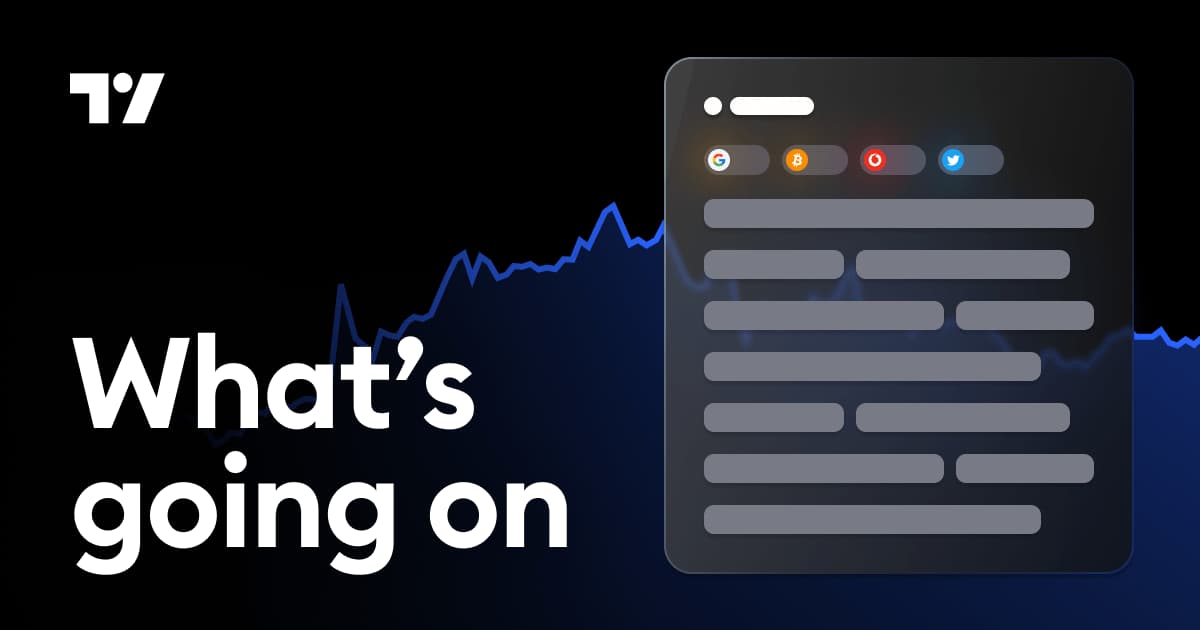
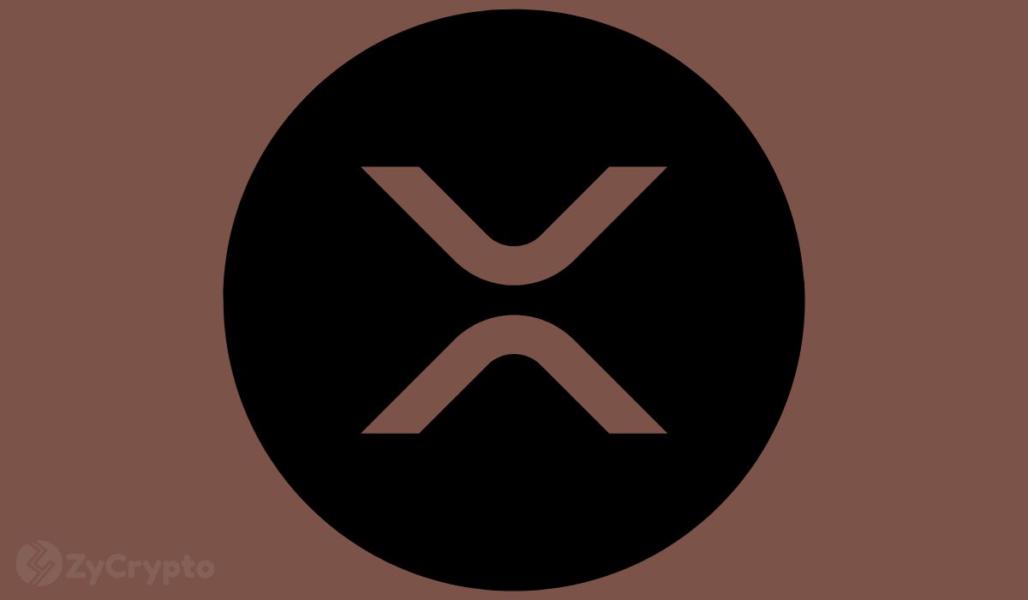
Ripple Labs XRP is capturing the spotlight again as analysts confirm a bullish breakout that could drive the cryptocurrency to huge price levels.
Select market data provided by ICE Data Services. Select reference data provided by FactSet. Copyright © 2025 FactSet Research Systems Inc.Copyright © 2025, American Bankers Association. CUSIP Database provided by FactSet Research Systems Inc. All rights reserved. SEC fillings and other documents provided by Quartr.© 2025 TradingView, Inc.

Sarah Gutman is an OB-GYN and complex family planning specialist in Philadelphia. Every week, she prescribes misoprostol and mifepristone. Sometimes she gives them to patients to manage a miscarriage or postpartum hemorrhage. Sometimes, they are not for pregnancy care at all: Misoprostol can prepare patients for a hysteroscopy, IUD insertion, or endometrial biopsy.
Though misoprostol and mifepristone are best known as the two components of medication abortion (referred to by many as the “abortion pill”), what they actually do is help soften the cervix and cause contractions, making them vital for a variety of gynecological uses. Yet because they are involved in medication abortions, Gutman is worried about whether doctors like her will be able to continue offering them. While prescribing misoprostol and mifepristone for reasons other than abortion technically remains allowed everywhere, “abortion bans create confusion, fear, and distrust,” she said. There are already signs that providers, patients, and pharmacists might now avoid these medicines out of fear of being prosecuted. Doctors also worry that medical training in abortion-related procedures, namely dilation and curettage, could be restricted or lost in some states. Besides abortion, these procedures can be used to treat heavy bleeding or evaluate the uterus for cancer.
Despite the shroud of stigma that has been attached to abortion—both surgical and medication—the medical methods behind pregnancy terminations are ordinary, critical elements of routine gynecological care. By creating legal gray areas and exacerbating existing stigma, the reversal of Roe v. Wade may now leave many doctors profoundly limited in how they can treat common health conditions that have nothing to do with pregnancy or abortion. Across the country, there will be unexpected consequences for people seeking care associated with the uterus, ovaries, and cervix—including those already dealing with chronic reproductive illnesses that have long been underfunded, understudied, and undervalued.
This problem stems from a deeper issue with how medicine views “women’s bodies” and particularly the “female reproductive organs.” Like abortion—itself a treatment sought for a number of reasons—these organs have long been culturally deemed as solely reproductive, and their functions viewed as constrained within the limits of producing pregnancies. The language we use to describe them re-emphasizes this bias, implying that their only function is to create a baby, when in fact the uterus and ovaries help support bodywide health and immunity throughout a person’s life. This bias has shaped the direction of American gynecology, which began with efforts to increase the reproductive potential of enslaved Black women. Even today, the Gynecologic Health and Disease Branch of the National Institutes of Health is subsumed under NICHD, the National Institute of Child Health and Human Development.
Likewise, the tools of abortion have come to be considered inextricable from pregnancy termination—erasing the fact that at their core, these are medical technologies with expansive uses and benefits in addition to the lifesaving care that is abortion.
The reality is that medical tools serve a wide variety of purposes, even across medical disciplines. Take misoprostol, for instance: mifepristone’s counterpart in a duo that many know by the name “medication abortion.” Misoprostol initially began as a treatment for stomach ulcers. In the 1980s, activists in Brazil discovered its abortifacient properties and developed the world’s first grassroots abortion pill network. Decades later, this wonder drug is also used to soften or “ripen” the cervix to facilitate hysteroscopy, endometrial biopsy, and the insertion of an IUD. All of these can be performed in the diagnosis, treatment, and management of various chronic illnesses; hormonal IUDs, for instance, are one tool doctors use to manage endometriosis or chronic pelvic pain.
Its slightly less famous cousin, mifepristone—which increases the effectiveness of misoprostol for inducing abortion—can be used in the management and treatment of fibroids and Cushing’s syndrome by blocking progesterone.
These medications are already difficult to access in other parts of the world where abortion is highly stigmatized and restricted—particularly mifepristone, which has fewer gynecological uses. In a 2021 research paper on misoprostol use in Francophone Africa, for instance, medical sociologist Siri Suh described misoprostol as “widely recognized as an essential obstetric medication,” yet added that “the stigma of abortion stalls its integration into routine obstetric care and availability to the public.” Suh’s ethnographic and interview data revealed that misoprostol is highly inaccessible due to a combination of legal restrictions and widespread abortion stigma.
There are already worrying signs of this pattern repeating across the United States. Linda Bradley, an OB-GYN at the Cleveland Clinic in Ohio who specializes in treating fibroids and menstrual disorders, said that recently a post-menopausal patient reported that she had been “harassed” by her pharmacist when she was trying to fill her prescription for misoprostol. This was despite the fact that her prescription was not in a high enough dose to be used for abortion and that “there’s no way a 70 year old’s gonna be pregnant,” Bradley said.
Bradley had prescribed the medication to help soften the cervix so she could perform an operation to remove uterine fibroids, growths that can cause heavy menstrual bleeding and pelvic pain. Misoprostol can be particularly important when doing procedures on post-menopausal women, because the cervix tends to close up and toughen after menopause.
The tools of surgical abortion may also be in peril. This type of abortion can be performed through the dilation of the cervix, followed by a curettage, or scraping, of the uterus, commonly referred to as a D&C. This procedure, which can also involve manual or vacuum suction, removes the current lining of the uterus as well as any other contents, including pregnancy, tumors, infections, or other growths. (For later gestation, doctors typically use D&E, or dilation and evacuation by suction and instruments—which has long been highly restricted across the U.S.)
But D&C is more than an abortion tool. It’s long been used to both treat chronic menstrual disorders and sample the lining of the uterus to check for conditions like cancer. “It’s basically like a biopsy,” said Tami Rowen, an OB-GYN and sexual health expert at the University of California, San Francisco. Doctors use D&C to clear out the uterus after childbirth or miscarriage, and to fully evacuate the uterus following a hysteroscopic surgery for fibroids or uterine cancer. It’s also used to remove the uterine lining (which grows back) in order to treat heavy bleeding stemming from fibroids or polycystic ovarian syndrome. In some cases, a D&C for heavy bleeding can be a matter of life and death.
Yet again, simply because D&C is associated with abortion, increased stigma means that medical residents in states where abortion is banned will likely get inadequate training in this common technique. A study published in April in the journal Obstetricians and Gynecologists predicted that between 43.9 percent and 56 percent of OB-GYN residents would lack abortion training if Roe was overturned. Research on Catholic hospitals in the U.S., where abortion training is already restricted, bears this out: A 2020 survey found that nearly half of OB-GYN residency programs at faith-based hospitals reported their own abortion training as “poor,” with one-quarter of residents not performing enough D&C procedures to meet graduate training requirements.
This is concerning because training in D&C is often how gynecological health providers become comfortable working with the cervix and uterus, said Rowen, which in turn allows them to routinely perform uterine biopsies, insert IUDs, and evaluate uteruses. Even if they still learn the basic procedure, not getting enough practice would mean that they are less competent and capable of handling emergencies. “The lack of abortion access is going to harm our patients,” said Rowen. “But as physicians, we are going to lose the ability to perform a critical skill well. And that skill allows us to help treat patients who have a myriad of gynecologic problems that will help preserve their fertility, treat cancer, and also save their life.”
Being less comfortable with D&C could result in OB-GYNs escalating the procedure: sending patients to the operating room, where they face general anesthesia, higher risks of complications, and greater costs, says Meg Autry, a professor and interim chair of obstetrics and gynecology at UCSF Fresno. “The less experienced you are, the worse it is for the patient,” she said. If providers don’t have the option of misoprostol, there will also be a higher risk of laceration and injury to the cervix and uterus when doing any procedure inside the uterus. Limiting the availability of misoprostol and D&C training “certainly limits what you can offer to your patient and I would say limits the standard of your care,” Autry said. “That’s true for fibroids, it’s true for cervical dysplasia, it’s true for endometriosis, and it’s true for pregnancy.”
“These are incredibly essential tools in our arsenal to try to help women,” added Erin Bradley, an OB-GYN at Massachusetts General Hospital and a district chair-elect of the American College of Obstetricians and Gynecologists. “And who knows? We don’t know what may be next and what we might lose access to in terms of treatment.”
Make no mistake: Abortion itself is routine, lifesaving, essential medical care. Yet labeling the tools of abortion as purely reproductive, and attaching stigma and criminality to these medical practices, harms not only patients far beyond those who are pregnant, but the very field of gynecology. This limited framework mirrors a broader problem in science’s treatment of the “female body.” Rendering the bodies of half the population as purely reproductive has produced countless blind spots in science—overlooking the immensely regenerative properties of these organs, for instance, which could otherwise be used to improve upon various facets of medical research. After all, countless medical breakthroughs wouldn’t have been possible without the cells scraped off Henrietta Lacks’ cervix (and used without permission).
There are myriad examples of how this narrow lens harms medicine: For one, the labeling of endometriosis as purely a “reproductive disease”—rather than one that involves bodywide inflammation—has prevented researchers from exploring potential cures beyond hormones and surgery. The historical overfocus on ovaries as “egg baskets” delayed a broader appreciation that these glands are also responsible for producing powerful hormones that support the heart, brain, and bones throughout a person’s life. And an overemphasis on fertility in medicine often limits patients from being able to choose elective sterilization procedures such as hysterectomy, even when it is critical to their quality of life, because doctors fear they will regret losing the ability to have children.
The divide between “abortion care” and “reproductive health” is one that is made along moral fault lines, not scientific ones. It is impossible to separate out abortions from gynecological health care in general: Just as you can’t “target” your abs with diet and exercise, you can’t simply remove these tools from medicine without expecting dire and wide-ranging repercussions. Abortion bans continue medicine’s tendency to look at the female body as purely reproductive, while making the consequences of this myopic mislabeling more visible and extreme. Anyone with a cervix, uterus, and ovaries—and not just those who can or want to get pregnant—is likely to suffer the consequences.
Slate is published by The Slate Group, a Graham Holdings Company.
All contents © 2025 The Slate Group LLC. All rights reserved.
Slate relies on advertising to support our journalism. If you value our work, please disable your ad blocker. If you want to block ads but still support Slate, consider subscribing.
Already a member? Sign in here